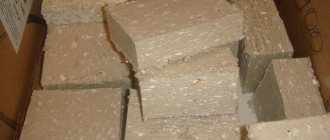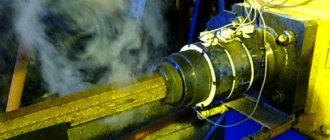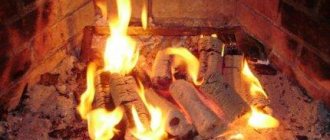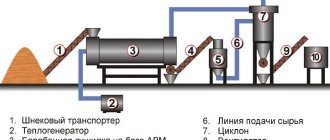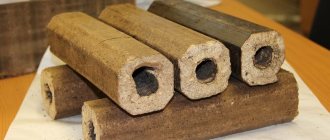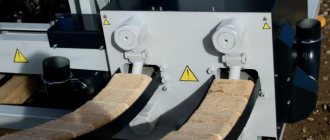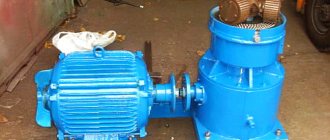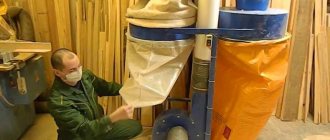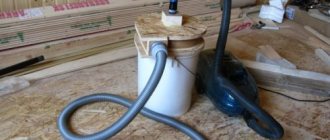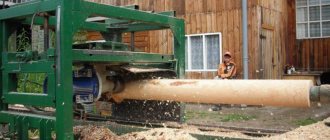Firewood that would burn for a long time, provide a lot of heat and little ash, and would not emit sparks or soot—the dream of the owner of a country house with stove heating or a fireplace. These are the properties that sawdust briquettes have, which you can not only purchase, but also make with your own hands. It is worth familiarizing yourself with the process of their manufacture. It is so?
We will tell you how to make fuel briquettes for use in heating a country house or cottage. The article we have proposed describes in detail the technology for producing logs from pressed sawdust. Do-it-yourselfers will find brief instructions on how to assemble a pressing machine.
Benefits of sawdust logs
The following arguments can be given in favor of briquettes pressed from sawdust:
- Long burning time - 4 hours.
- Minimal smoke generation.
- Environmentally friendly. The starting materials are natural materials, so you can fertilize the beds with ash.
- High energy output. It far exceeds the energy capabilities of firewood and is comparable only to high-quality coal.
- Constant combustion temperature.
- Economical. The cost of 1 ton of such fuel will be cheaper than the corresponding amount of firewood or coal.
- Possibility of self-production.
There are also disadvantages. The main one is the fear of moisture. They cannot be stored in the open air, because... they will quickly absorb moisture and therefore will burn poorly. Therefore, it is necessary to allocate a dry room for storage.
Any significant mechanical impact on sawdust briquettes is contraindicated. If you buy special equipment for their production, the cost will be high and not always justified.
Replacing coal and firewood with sawdust briquettes makes heating a country home more environmentally friendly. While heating with wet wood leads to the release of harmful substances, “Eurowood” is completely safe in this regard
It is profitable to set up handicraft production if the sawdust is free, and you can use existing equipment for installation.
Sawdust and shavings for smoking
Sawdust, smoldering slowly and producing a lot of smoke, is an excellent material for lighting a home smokehouse.
Sawdust from alder, oak and fruit crops: apple, cherry, apricot, sea buckthorn are best suited for a smokehouse. But the most unsuitable trees, the sawdust of which should not be used for these purposes, are aspen and conifers.
Sawdust for smoking must be of high quality, so before use, make sure that there is no mold or traces of chemical treatment on it. Soak the sawdust in warm water for 4-5 hours, then dry (optimal humidity is 50-70%).
Smokehouse in the country - choosing the appropriate option Is it possible to imagine a day outside the city without smoked fish or a piece of meat? Especially if these “delicacies” are obtained using a personal smokehouse?
Of course, these are not all the ways to use sawdust and shavings in a summer cottage. Craftsmen use them to make wall plaster, homemade sawdust concrete, various crafts, flavor bags, use them as fuel in special boilers, and use them as bedding for domestic animals...
Have you also mastered this eco-friendly material?
Types of fuel briquettes
Briquettes are divided into types depending on their shape. Mainly the following types can be found on the market:
- RUF. These are pressed rectangles measuring 15 x 9.5 x 6.5 cm. They are made from natural wood sawdust with the addition of special components.
- Nestro. Visually, these are cylinders with a diameter of 6 to 9 cm and a length of 5 to 35 cm, without holes. The material for production is pressed wood pulp. It is dried, placed in a loading container, and then fed through a screw for pressing. Dispensers distribute the mass into molds under pressure.
- Pini kay. In shape they are polyhedra with the number of faces from 4 to 6. During the production process they are subjected to processing at high temperatures and pressing under high pressure, up to 1100 bar. As a result, combustion efficiency, moisture resistance, and density increase.
The chemical composition and heat transfer of all these types of pressed sawdust are the same, they differ only in density. This fuel is not characterized by sparks flying in different directions. Its high density and low hygroscopicity make it possible to store this fuel in a small pantry next to the stove.
In addition to sawdust, sunflower husks, buckwheat, paper, small branches, fallen leaves, and straw are used to produce briquettes. The equipment for this has a fairly simple design, and you can make it yourself
If you have the necessary raw materials to form briquettes, you can make them yourself.
Stages of creating an enterprise
As in any other field of activity, an entrepreneur must first of all register a business, find suitable premises and hire employees.
Business registration
If you plan to produce relatively small volumes of products, then you can limit yourself to creating an individual entrepreneur and working under a simplified taxation system. To do this, just contact the local tax office with your passport and TIN. The production of briquettes does not require licensing or obtaining certificates.
Premises requirements
The premises must meet the following requirements:
- area – at least 500 sq.m.;
- availability of electricity and water supply, sewerage and heating (for work in winter);
- location in an industrial area or away from residential areas.
It is unlikely that a novice businessman will be able to build or purchase a workshop, so at first the premises will have to be rented.
We are recruiting staff
The staff typically includes a general manager, an accountant, a sales manager, operators, workers and a driver. At first, managerial and administrative positions can be performed by the entrepreneur himself alone. The number of workers depends on the chosen production method and type of equipment (for example, up to 9 people are required to operate a production line).
Ready briquettes
Equipment for the production of briquettes
In industrial conditions, the grinding of wood waste is carried out using special mechanisms - crushers. Such an important part of the technological process as drying is performed using drying machines, which come in two types - drum and aerodynamic.
Products are formed using a hydraulic press. With a force of at least 30 MPa, it compacts the mass. At the same time, there is no need to add any substances to the raw material for bonding, because under these conditions, due to compression and high temperature, wood glue - lignin - is released.
Briquettes of any shape can be produced using a mechanical impact press, but their density is not very high.
There is another method for producing “eurowood” - extrusion. It is based on the fact that with a force of about 40 MPa, the mass is pushed through calibrated holes by means of a screw, thereby forming products in the form of cylinders or hexagons. At the exit they are cut with special knives.
The productivity of screw extruders is higher than that of mechanical or hydraulic presses.
Manufacturers often apply a letter imprint to the surface of briquettes produced using industrial equipment. Basically, it is evidence of strict adherence to technology
It is irrational to buy such installations for making your own and preparing fuel briquettes; there are other options for this.
Sales market
The demand for wood briquettes is constantly growing. This is mainly due to their economical consumption and ease of transportation and storage. In Europe, this type of fuel has been in demand for quite a long time. In Russia, this material appeared relatively recently.
However, the market has already actively begun to take shape, and the fuel business in this area has begun to gain momentum. Therefore, there is an opportunity to take our place in this matter. The good thing is that sources of raw materials for the manufacture of these products can be found in abundance in almost any area of our homeland.
Dachas, country houses, recreation centers - consumers of fuel briquettes - are heated by boilers or fireplaces. Basically, these objects do not have heating communications, or they are significantly outdated and in a worn-out condition. Today you can even buy fuel pellets and European firewood in supermarkets.
Various organizations may well become a separate branch of sales of these products: agricultural plants, poultry farms. Almost every enterprise that has boiler rooms runs on solid fuel. It will not be difficult to interest these organizations in purchasing this material. You just need to calculate the benefits of the deal. This includes improving the environmental situation in the area where the enterprise is located and reducing the costs of transportation and storage. Basically, all current boiler houses operating on solid fuels can operate on the specified material.
Independent production of briquettes
The main supplier of sawdust is the sawmill. It doesn’t matter what type of wood it is, the main criterion is moisture content. It should not go beyond 12%. In the total mass, the amount of spoiled wood should not exceed 5%.
Description of the technological process
This process is not very complicated and generally consists of five stages:
- Purification of raw materials. It is necessary to remove dirt and excess impurities.
- Grinding. The size of the sawdust matters - a maximum of 0.6 cm.
- Pressing.
- Drying.
- Warehousing.
After the first preparatory stage, the mass is mixed with dry, powdered clay, proportion 10: 1. Next, adding a little water, begin mixing. Please note that the thickness of the mixture should be medium. The ability of it to hold its shape, the drying time and the finishing density of the products depend on this indicator.
The next step is loading the resulting mixture into the bunker of the briquetting equipment. Then the actual pressing in molds. After all, all that remains is to dry the finished briquettes well. Cardboard soaked in water is sometimes added to the clay mixture. In this case, the flammability of the fuel increases.
Homemade pressing plants
At home, you can make equipment in three versions:
- with hydraulic drive;
- with manual drive;
- with jacks.
The manual device is the simplest. It can be attached to the wall. The frame for it is made of a steel pipe or angle by welding.
It is impossible to create a full-fledged technological line for the production of briquettes at home, because it is very expensive and requires large areas. Craftsmen at home use homemade machines of various designs
One cannot miss the point that when the sawdust is large, it must be crushed before pressing. A simple cutter is suitable for this, but it is better to mechanize this process. It’s good if you have a machine for grinding grass at home, it will also cope with crushing sawdust.
Some craftsmen adapt outdated washing machines for this purpose. For this purpose, the activator is supplemented with knives.
Manual machine
A press for the production of briquettes from sawdust at home is fixed on the wall with dowels. A stationary form is attached to the lower part of the structure.
Its geometry can be any. To control the mechanism, a lever is needed, so a hinge is mounted on the top crossbar, through which a piece of pipe or a long metal pin is attached.
The mold, installed motionless, will serve as a matrix, and the punch is attached to the lever. It is important to correctly calculate the length of the pipe so that the punch fits freely into the matrix.
For free movement of the punch it is necessary to provide a small gap. To remove moisture from the matrix mold, a hole is drilled in its bottom.
The second option for a manual press is a floor mechanism. Its design is identical to the wall fixture, the only difference is that the welded frame to which the main parts are attached is installed on a flat horizontal surface.
Another type of manually operated equipment is a screw press. It is very easy to use. The lower part is a perforated molding container located under the bed.
When tightening the screw, the pressure necessary for pressing is created. The performance of such a device is very low. A lot of time is spent on loading, tightening the screw, and removing finished products. Lever models have more potential.
Improved homemade version
Manual equipment can be improved by adding a jack or hydraulic press. The shape is made square or round. The base is welded from channel. Racks - corner 100 x 100.
Round shapes are made from thick-walled pipes. The matrix is perforated so that the water released during compression escapes. To remove finished products, the bottom is made removable.
For this purpose, you can install a spring inside the matrix, attaching it to the bottom, but then it must be tightly welded. A disk is attached to the spring. When the product is formed, it contracts, and when the rod reverses, it straightens and pushes the finished briquette out of the mold with a disk.
It is impossible to obtain super-strong products with such an installation, but the briquette will be quite dense, conveniently shaped and quite suitable for use
The rod is made from a pipe with a diameter of about 3 cm. A punch is attached to one end by welding, which fits into the matrix with a small gap. The opposite end of the rod is fixed to a hydraulic jack or press.
Before loading the raw material, it must be mixed well. This requires a special container. They make it from sheet steel or adapt a drum from an old washing machine and install it on racks. You can mix it with a mixer or in a concrete mixer.
From the drum, the wood pulp is supplied for pressing into molds along a tray made of sheet steel. It is best to dry briquettes in an oven, but you can also dry them in the sun. The main thing is that the humidity is minimal. Only a dry type of fuel will give off such an amount of thermal energy that is enough to heat the premises.
Stationary briquetting press
To make such a press, you will need a 2.5 kW motor if you are working on a 220 V network. If three-phase voltage is supplied, a 9 kW motor will do. In addition, you need a gearbox, shaft, bearing, auger, heating elements, and a relay for temperature control.
The engine, gearbox and other components are mounted on a welded frame from an angle. It is installed on racks made of pipes. The auger in this design consists of two parts. One of the bottoms transforms sawdust into a loading container, the second acts as a punch. The role of the matrix is played by the pipe.
As a result of heating the wood pulp and the penetration of steam into it, the plastic viscosity of sawdust increases, which provokes the release of natural binding components. For this reason, sawdust can be loaded into the hopper without any additives
Before starting the press, the pipe is heated using heating elements to 260⁰. Heating is regulated using a relay. The compaction of the briquettes is controlled by a square welded to the pipe. As a design flaw, large heat losses into the environment can be noted. But at the same time, the quality of the briquettes increases significantly.
Business planning
It is advisable to start opening a mini-factory for the production of fuel briquettes by drawing up a business plan. It is better to order a full feasibility study of the project from specialists. You can also make an approximate calculation of economic indicators yourself by collecting certain data for your region: prices for equipment and its technical characteristics, the cost of raw materials, the cost of utilities, etc.
The main goal of developing a business plan for the production of fuel briquettes is to draw up a program of economic activity of the enterprise, within the framework of which it is optimal to distribute available resources to achieve the set goals. During its development, it is necessary to find out the degree of reality of achieving the intended results. It must reflect the reasonableness of the costs and profitability of the project. It is useful to learn how to write a proper business plan. Approximate data for calculating the profit and payback period of the project are given in the following table:
| Costs for production of 1 ton of briquettes | ||
| 1. | Raw materials (2 tons) | 400 rub. |
| 2. | Electricity (100 kW/hour) | 550 rub. |
| 3. | Thermal energy (1 MW/hour) + price of dry wood waste | 100 rub. |
| 4. | Salary (2 employees per shift at a rate of 20,000 rubles/month with taxes) | 360 rub. |
| Total: | 1410 rub. | |
| Income | ||
| 1. | Productivity per month for single-shift work (0.5 t/hour × 8 hours × 21 days) | 84 tons |
| 2. | Capacity per year (84 tons × 12 months) | 1008 tons |
| 3. | Minimum selling price | 5000 rub./t |
| 4. | Revenue per month | 420,000 rub. |
| 5. | Revenue per year | RUB 5,040,000 |
| 6. | Profit per month | RUB 301,560 |
| 7. | Profit per year | RUB 3,618,720 |
This table shows only direct costs; packaging, delivery, taxes and other mandatory payments are not taken into account. In addition, productivity largely depends on the quality of equipment and the level of qualifications of personnel. But, as practice shows, such productions pay for themselves in an average of two years of operation.
How to calculate the need for fuel briquettes?
Having decided to switch the heating of your home to sawdust briquettes, it is better to immediately calculate how many of them will be needed to last for the entire period. Here you need to take into account the temperature that needs to be maintained, the area of the room, the thickness of the walls and other factors.
The quality of eco-fuel also plays an important role. The heat output of 1 kg of high-quality briquettes can reach up to 4.4 kW. Products made at home for use in brick ovens or metal bath units will not produce such a result.
Let's say a house with an area of 100 m² is well insulated, the heating period lasts 190 days, the boiler operating coefficient is 0.7. Then 100 x 190 x 24 x 0.7 x 70 = 22,344 kW. If we take into account that the efficiency of the furnace is 86%, the heat transfer will decrease to 3.9 kW. Investigator, you need a supply of briquettes of 22,344: 3.9 = 5.7 tons.
